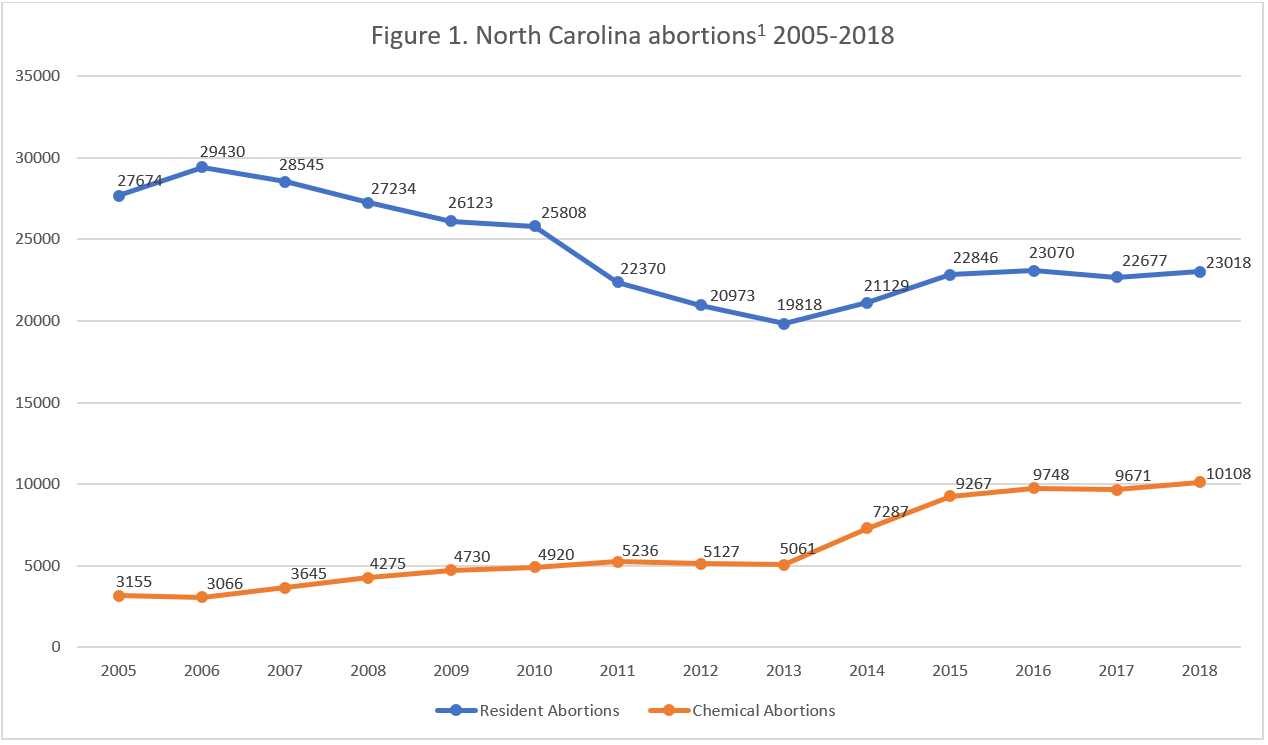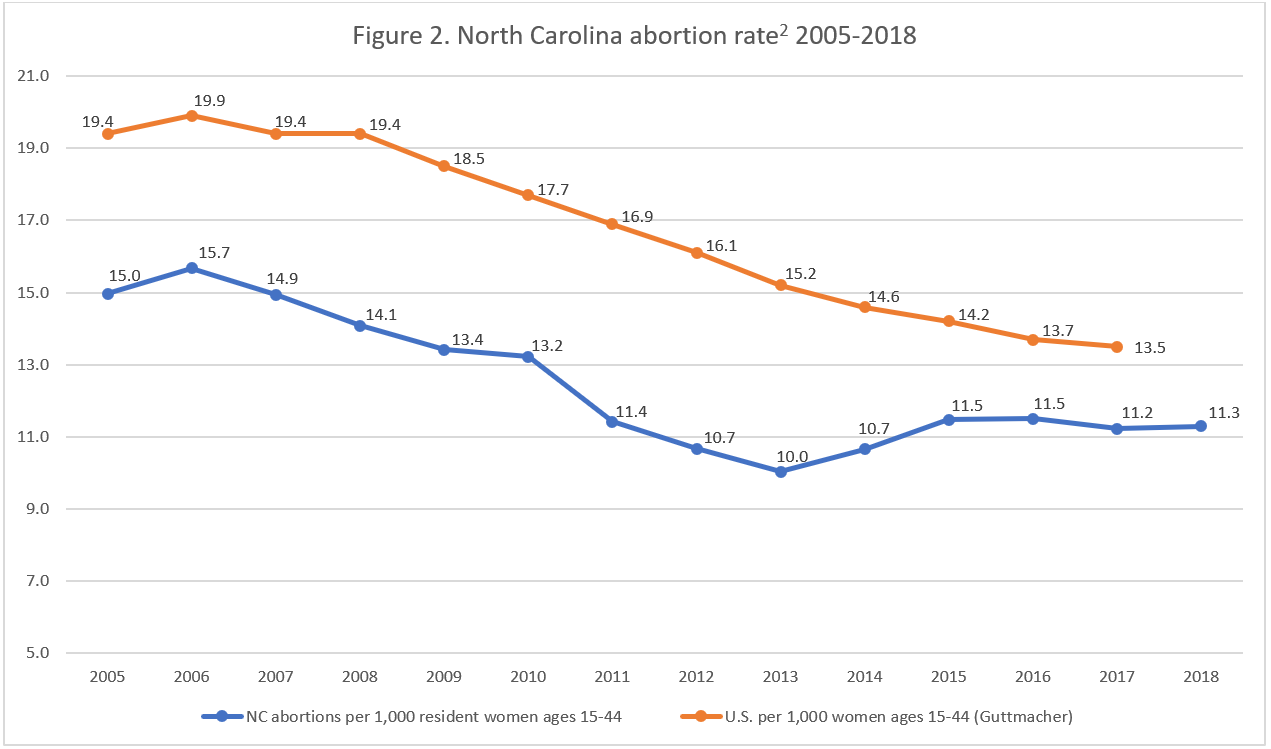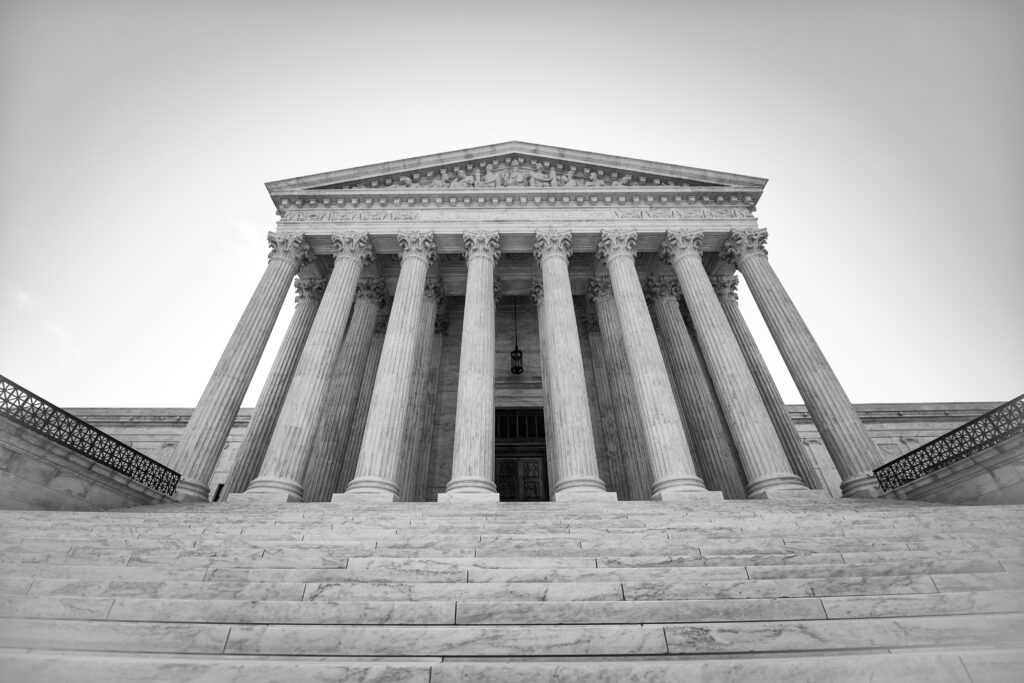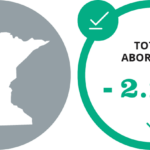Abortion Reporting: North Carolina (2018)
North Carolina’s abortion statistics for 2018 were published on the website of the North Carolina Department of Health and Human Services in September 2019. Abortions increased slightly from 2017 to 2018.
Changes in North Carolina Abortions, 2017-2018

North Carolina resident abortions only. Information on Planned Parenthood’s North Carolina market share is not publicly available.
Abortion Totals and Trends
In 2018, 27,581 abortions were performed in North Carolina, an increase of 1.5 percent from the 27,183 reported in 2017. Resident abortions also increased. Abortions performed on North Carolina residents, both in North Carolina and in other states, rose by 1.5 percent between 2017 and 2018. Chemical abortions performed on resident women increased by five percent (Fig. 1). The Charlotte Lozier Institute estimates that North Carolina’s resident abortion rate increased slightly from 11.2 abortions per 1,000 resident women of childbearing age in 2017 to 11.3 in 2018 (Fig. 2).
State Report Summary
Most of the information in North Carolina’s annual abortion report is for abortions performed on resident women. Of the 23,018 North Carolina resident abortions reported in 2018, 98 percent occurred in North Carolina, and two percent occurred in other states. However, not every state reports abortions back to North Carolina, so this number is likely an undercount. Relatedly, women from other states had abortions in North Carolina. North Carolina residents composed 81 percent of all abortions reported in North Carolina in 2018.
More than half the abortions performed on residents were on women in their twenties (57 percent). Twenty-seven percent were on women ages 20 to 24 and 29 percent on women ages 25-29. Nine percent were performed on girls age 19 or younger, of whom 62 (0.3 percent) were under the age of 15. Eighteen percent of the abortions were performed on women ages 30 to 34 and 14 percent on women age 35 and older. Three percent were performed on women whose ages were not reported.
Non-Hispanic African American women composed the largest racial group undergoing abortions (45 percent of the total). Thirty-two percent were performed on non-Hispanic white women. One percent were performed on non-Hispanic American Indian women, three percent on non-Hispanic women of other races, and four percent on non-Hispanic women of multiple races. Twelve percent of the abortions were performed on Hispanic North Carolina residents. Two percent were performed on resident women of unknown race and ethnicity. The Charlotte Lozier Institute estimates that North Carolina’s non-Hispanic white abortion rate in 2018 was 6.3 abortions per 1,000 resident women between the ages of 15 and 44, less than a third of the non-Hispanic black abortion rate of 21.5.
Fifteen percent of the abortions were performed on married women, 77 percent on unmarried women, and nine percent on women of unknown marital status. Nine percent of the abortions were on women with fewer than 12 years of education. Twenty-five percent were performed on women who had completed 12 years of schooling, and 60 percent were on women with 13 years of education or more. Six percent of the abortions were performed on women whose level of education was unknown.
More than half of the women reported that this was their first abortion. Fifty-four percent had never had an abortion previously, while 23 percent had one previous abortion and 14 percent had two or more previous abortions. The number of prior abortions was not reported for nine percent of the women. In contrast, many of the women getting abortions were already mothers. Twenty-six percent had one living child and 36 percent had two or more children, while 37 percent had no children. One percent did not report how many children they had.
The majority of the abortions performed on North Carolina residents occurred in the first trimester. Sixty-five percent were performed at eight weeks of gestation or earlier, and 21 percent occurred between nine and 12 weeks. Not quite six percent were performed between 13 and 15 weeks of gestation. Three percent (780 abortions) were performed between 16 and 20 weeks. Of these, 728 abortions were performed on North Carolina residents in North Carolina, and 52 were performed on North Carolina residents in other states. There were 36 abortions performed at 21 weeks of gestation or later, one of which was performed in North Carolina. The other 35 abortions at or after 21 weeks were performed in other states.
Fifty percent of the abortions were performed using curettage procedures, and 44 percent were chemical abortions. There was one intrauterine instillation abortion and two hysterectomy or hysterotomy procedures. Six percent of the abortions were performed using unknown methods.
Late-Term Abortion
Since 1973, North Carolina law has limited abortion at 20 weeks unless the mother’s life or health was at risk. Unlike more recent state laws that limit abortion at this point in pregnancy to protect babies who can feel pain, North Carolina’s law did not refer to fetal pain. In 2015, the North Carolina legislature narrowed the health exception to explicitly exclude psychological and emotional factors. Following the amendment, North Carolina abortion providers sued the state. In 2019, a federal court blocked the law as unconstitutional, noting that despite the fact that there had been no prosecutions under the old version of the law for more than 40 years and that the state insisted it did not intend to prosecute violations of the amended law, the new amendment suggested that there was a real possibility that North Carolina might enforce the law.
At first glance, a very small proportion of the abortions performed on North Carolina residents in North Carolina are reported to occur after 20 weeks in pregnancy. Between 2009 and 2018, 69 abortions at or after 21 weeks were performed in North Carolina, or 0.03 percent of the 222,336 abortions performed on residents in-state over that same time period, with just one post-20 week abortion performed each year from 2016 onward, when the amendment went into effect. However, North Carolina does not report the gestational ages at which abortions are performed on nonresident women, and a relatively high number of resident abortions occur at unknown gestational ages (six percent, or more than 1,300 abortions in 2018), so the actual number of abortions performed in North Carolina at 21 weeks or later could be higher. While enjoining the 20-week law, the court noted that North Carolina abortion providers had not openly violated the old version of the law, but also pointed out, “There appears to be some dispute, however, regarding whether past abortions provided by Plaintiffs after the twenty week point fell within the pre-amendment medical emergency exception.”
State Ranking
In 2016, the Charlotte Lozier Institute evaluated abortion reporting in the 50 states, New York City, and the District of Columbia. North Carolina tied for 29th best. Currently, the report focuses on abortions obtained by North Carolina residents, but North Carolina could improve its reporting by including more information (such as gestational age, type of procedure, and demographic information) on all abortions performed in the state, including those obtained by non-resident women. The report could also identify the states to which North Carolina residents traveled for abortions. North Carolina could collect and report information on complications resulting from abortion, as other states do. Additionally, North Carolina could report the number of abortions performed at each of the fourteen abortion centers in the state.


- The North Carolina Department of Health and Human Services cautions that abortions were underreported 2011-2014.
- Starting with the 2018 abortion reports, abortion rates are calculated by the Charlotte Lozier Institute to allow for easier state-to-state and year-to-year comparisons. Rates were calculated by CLI using population estimates from the United States Census Bureau. The rates were calculated using the following formula: (abortions performed on North Carolina residents ÷ number of resident women ages 15-44) x 1,000. Rates may differ slightly from previous CLI articles due to revised population estimates.





















